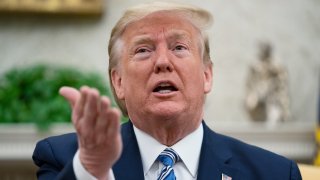
Defending his early response to the coronavirus pandemic, President Donald Trump wrongly claimed that in late February, Anthony Fauci, director of the National Institute of Allergy and Infectious Diseases, was saying, “This is no problem. This is going to blow over.”
In a Feb. 29 interview, Fauci said that “right now at this moment” the risk was “low” and there was “no need” for people “to change anything that you’re doing on a day-by-day basis.” But he added that “this could change,” that people needed to be wary of “community spread,” and that it could develop into a “major outbreak.”
Trump’s comment came in response to a question about press reports that he ignored warnings about the growing threat of the coronavirus in more than a dozen classified intelligence briefings included in the President’s Daily Brief in January and February.
Reporter, April 28: Mr. President, can you clarify what your intelligence advisers were telling you back in January and February? Were you warned about what was happening with coronavirus and the threat to this country? Should there have been stronger warnings? What were you hearing every day?
Trump: Yeah, yeah. Well, I think probably a lot more to the Democrats, because a month later, Nancy Pelosi was saying, “Let’s dance in the streets of Chinatown.” You go back and you take a look at — even professionals, like Anthony [Fauci], were saying this is no problem. This is late in February: “This is no problem. This is going to blow — this is going to blow over.” And they’re professionals, and they’re good professionals.
Most people thought this was going to blow over. And if you can go — we did, I think, on January — toward the end of January, we did a ban with China. That was a very — I think you just said, a little while ago, that was a very important step. And then ultimately, we did a ban on Europe. That was very early in the process.
Because if you take the ban and you look at it, I was badly criticized by Sleepy Joe Biden, by others. I was criticized horribly for — I mean, he called — he said all sorts of things. We won’t even say it. And then he apologized because — two weeks ago, he put out a statement that I was right. We did a ban. … And many people — Democrats, professionals, probably Republicans — said that this would never happen, there’d be nothing; no big problem. You saw that, I think, better than anybody, Deborah. This was after the ban. So, obviously, I took it very serious. I’m not going be banning China from coming in if I didn’t take it seriously. And I did that early.
There are several misleading statements in this response:
- As we have written, House Speaker Pelosi did not say, “Let’s dance in the streets of Chinatown.” During her visit on Feb. 24 — three weeks before six Bay Area counties implemented shelter-in-place restrictions — she told people it was safe to eat and shop in Chinatown at a time when tourism was suffering because of the novel coronavirus, which originated in China late last year.
- Trump did not “ban” travel from China. There were exceptions, including for Americans and their family members, and for cargo shipments between the countries.
- Biden did not “apologize” for criticizing the China travel restrictions. His campaign on April 3 said Biden supported Trump’s decision to impose travel restrictions on China, and argued that Biden’s comments about “Donald Trump’s record of hysteria and xenophobia” — made the same day as Trump announced the travel restrictions — were not a reference to those restrictions.
But here we’ll focus on Trump’s claim that in late February, “even professionals, like Anthony [Fauci], were saying this is no problem” and “this is going to blow over.” That’s not what Fauci was saying at that time.
U.S. & World
The day's top national and international news.
This isn’t the first time Trump has misleadingly cited Fauci’s late February assessments of the virus.
On April 12, Trump retweeted a post by DeAnna Lorraine — a recently defeated California Republican congressional candidate — in which Lorraine claimed that “Fauci was telling people on February 29th that there was nothing to worry about and it posed no threat to the US public at large.” She ended her post, “Time to #FireFauci…”
In a Feb. 29 interview with Kristen Welker and Peter Alexander on NBC’s “Today” show, Fauci said the risk from COVID-19 “is still low,” and he said there was no need for people to change their daily routines “at this moment.” But he warned that could change if “you start to see community spread.”
Alexander, Feb. 29: So, Dr. Fauci, it’s Saturday morning in America. People are waking up right now with real concerns about this. They want to go to malls and movies, maybe the gym as well. Should we be changing our habits and, if so, how?
Fauci: No. Right now, at this moment, there’s no need to change anything that you’re doing on a day-by-day basis. Right now the risk is still low, but this could change. I’ve said that many times even on this program. You’ve got to watch out because although the risk is low now, you don’t need to change anything you’re doing. When you start to see community spread, this could change and force you to become much more attentive to doing things that would protect you from spread.
Welker: Dr. Fauci, quickly, how does this all end?
Fauci: You know, it ends if you — it depends on the nature of the outbreak. I mean, this could be a major outbreak. I hope not. Or it could be something that’s reasonably well controlled. At the end of the day, this will ultimately go down. Hopefully we could protect the American public from any serious degree of morbidity or mortality. That’s the reason why we’ve got to do the things that we have in our plan.
Fauci’s comments came as concerns were just starting to emerge in the U.S. about “community spread,” meaning that the “source of infection is unknown,” as the Centers for Disease Control and Prevention explains, and the virus may have been transmitted person-to-person from someone in the U.S., rather than by exposure to an infected traveler who had brought it to the U.S.
On Feb. 26, Nancy Messonnier, the director of the National Center for Immunization and Respiratory Diseases, said in a telebriefing that the CDC fully anticipated seeing community spread of the virus within U.S. borders.
“It’s not so much a question of if this will happen anymore,” she said, “but rather more a question of exactly when this will happen and how many people in this country will have severe illness.”
On Feb. 28, Messonnier reported that there were three confirmed cases of person-to-person spread in the United States. She said that while “the immediate risk to the general American public remains low … [o]ur guidelines and advice are likely to be interim and subject to change as we learn more.”
At a press conference on Feb. 29, the afternoon after his “Today” show interview, Fauci reiterated that the country as a whole, at that time, “still remains at low risk. But when we say that, we want to underscore that this is an evolving situation.”
Fauci, Feb. 29: But as we say this, we need to prepare for further challenges. And we will have them. You will hear about additional cases that will be coming on. You should not be surprised by that, but to realize that that is something that is anticipated when you get community spread.
So when you have cases throughout the world, the way we’re seeing now — South Korea, Italy, Iran and places like that — the United States cannot be completely immune to that. The challenge is how we deal with it.
It wasn’t until two weeks later, on March 16, that Trump imposed social distancing guidelines.
One could question whether Fauci was slow to publicly call on the federal government to enact those guidelines. But Fauci’s comments in late February were far different from Trump’s claim that Fauci said, “This is no problem. This is going to blow over.”
FactCheck.org does not accept advertising. We rely on grants and individual donations from people like you. Please consider a donation. Credit card donations may be made through our “Donate” page. If you prefer to give by check, send to: FactCheck.org, Annenberg Public Policy Center, 202 S. 36th St., Philadelphia, PA 19104.



